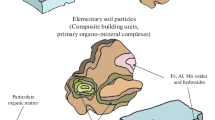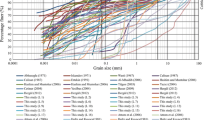In memory of Petr Nikolaevich Berezin
Abstract
The analysis of literature sources and a database on soil physical properties collected by the Department of Soil Physics and Amelioration of Soils of the Faculty of Soil Science of Moscow State University made it possible to compare three major constituents of the particle-size distribution analysis (PSDA): (a) the classification of soil separates with respect to their sizes and the classification of soil textures, (b) the procedures used to prepare soil samples for the PSDA, and (c) the specificity of the determination of the particle-size distribution by different methods. It was shown that there are good physical and statistical grounds for the conversion of data on the particle-size distribution from the Russian classification system into other systems. Much larger problems are related to the pretreatment of soil samples for the PSDA. The diversity of existing methods, classification schemes, and technical devices based on different physical principles (sedimentation and laser diffractometry) should be taken into account in the analysis and quantitative conversion of particle-size distribution data from a given classification system into another system. The Russian classification of soil textures and soil particle-size groups developed by N.A. Kachinskii has certain advantages and can be easily converted into other systems. In the choice of a particular system, it is important to take into account the goals of the study. Agreement between soil scientists concerning the major constituents of the PSDA has to be reached.
Similar content being viewed by others
References
P. N. Berezin, “Particle-Size Distributions of Soils and Parent Rocks,” in Current Physical and Chemical Methods of Soil Examination, Ed. by A. D. Voronin and D. S. Orlov (Mosk. Gos. Univ., Moscow, 1987), pp. 56–73 [in Russian].
P. N. Berezin, “Particle-Size Distributions of Soils and Parent Rocks,” Pochvovedenie, No. 2, 64–72 (1983).
A. F. Vadyunina and Z. A. Korchagina, Methods for Studying the Physical Properties of Soils (Agropromizdat, Moscow, 1986) [in Russian].
A. D. Voronin, Basic Physics of Soils (Mosk. Gos. Univ., Moscow, 1986) [in Russian].
GOST (State Standard) 12536-79: Soils. Methods of Laboratory Particle-Size and Microaggregate-Size Distributions, 1979.
N. A. Kachinskii, Soil Physics (Vysshaya Shkola, Moscow, 1965), Vol. 1 [in Russian].
V. N. Konishchev and V. V. Rogov, Methods of Cryological Studies (Mosk. Gos. Univ., Moscow, 1994) [in Russian].
J. Lozet and C. Mathieu, Dictionaire de science du sol (Lavoisier, Paris, 1990).
N. A. Platov, Basic Engineering Geology (INFRA-M, Moscow, 2005) [in Russian].
Theories and Methods of Soil Physics, Ed. by E. V. Shein and L. O. Karpachevskii (Grif, Moscow, 2007) [in Russian].
V. T. Trofimov, V. A. Korolev, E. A. Voznesenskii, G. A. Golodkovskaya, Yu. K. Vasil’chuk, and R. S. Ziangarov, “Sediment Science,” 6th ed., Ed. by V. T. Trofimov (Mosk. Gos. Univ., Moscow, 2005) [in Russian].
G. N. Fedotov, E. V. Shein, V. I. Putlyaev, T. A. Arkhangel’skaya, A. V. Eliseev, and E. Yu. Milanovskii, “Physicochemical Bases of Differences between the Sedimentometric and Laser-Diffraction Techniques of Soil Particle-Size Analysis,” Pochvovedenie, No. 3, 310–317 (2007) [Eur. Soil Sci. 40 (3), 281–288 (2007)].
E. V. Shein, Course of Soil Physics (Mosk. Gos. Univ., Moscow, 2005) [in Russian].
E. V. Shein and T. A. Arkhangel’skaya, “Pedotransfer Functions: State of the Art, Problems, and Outlooks,” Pochvovedenie, No. 10, 1205–1218 (2006) [Eur. Soil Sci. 39 (10), 1089–1099 (2006)].
E. V. Shein, T. A. Arkhangel’skaya, V. M. Goncharov, A. K. Guber, T. N. Pochatkova, M. A. Sidorova, A. V. Smagin, and A. B. Umarova, Field and Laboratory Methods of Studying the Physical Properties and Regimes of Soils (Mosk. Gos. Univ., Moscow, 2001) [in Russian].
E. V. Shein and L. O. Karpachevskii, Explanatory Dictionary of Soil Physics (GEOS, Moscow, 2003) [in Russian].
W. A. Jury, W. R. Gardner, and W. H. Gardner, Soil Physics (Wiley, 1991).
Cl. Mathieu and F. Pieltain, Analyse physique des sols (Lavoisier, Paris, 1998).
E. V. Shein, E. Yu. Milanovsky, and A. Z. Molov, “The Granulometric Composition: the Role of Soil Organic Matter in Data Distinctions between Sedimentation and Laser Diffraction Analysis,” Eur. Soil Sci. 39(Suppl. 1), 84–90 (2006).
Author information
Authors and Affiliations
Additional information
Original Russian Text © E.V. Shein, 2009, published in Pochvovedenie, 2009, No. 3, pp. 309–317.
Rights and permissions
About this article
Cite this article
Shein, E.V. The particle-size distribution in soils: Problems of the methods of study, interpretation of the results, and classification. Eurasian Soil Sc. 42, 284–291 (2009). https://doi.org/10.1134/S1064229309030053
Received:
Published:
Issue Date:
DOI: https://doi.org/10.1134/S1064229309030053




